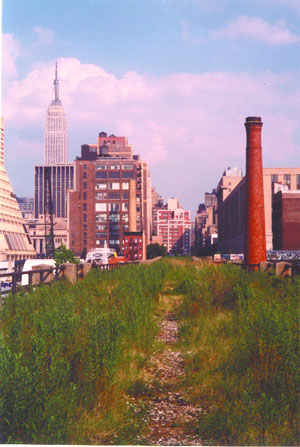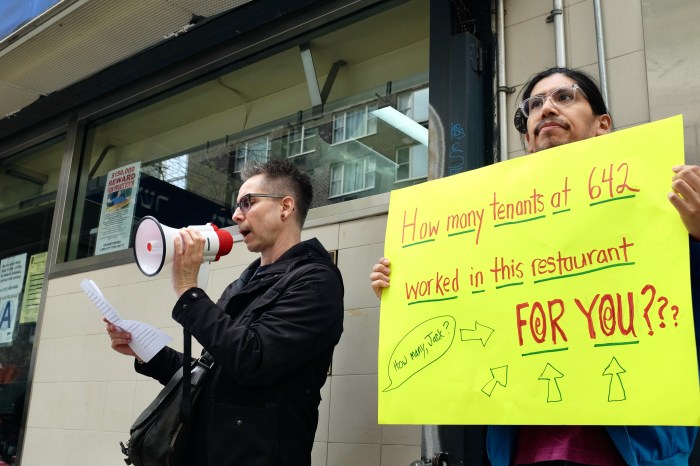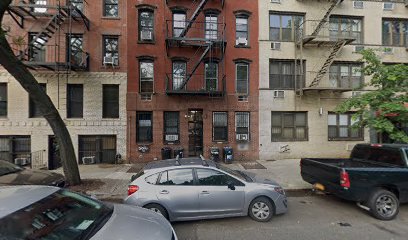By Albert Amateau
The conversion of the High Line into a 1.5-mile-long park between the Gansevoort Market and the Javits Convention Center, derided as a romantic folly two years ago, appeared last week to be a serious possibility, if not a sure thing.
At a Manhattan hearing of the federal Surface Transportation Board, which has jurisdiction over the nation’s railroads, Deputy Mayor Dan Doctoroff and City Planning Commissioner Amanda Burden and others testified that they foresaw the derelict rail viaduct being transformed into a green spine linking three evolving neighborhoods.
The High Line is the key to the future of the Gansevoort Market, the West Chelsea gallery district between 16th and 30th Sts. and the proposed new residential and commercial rezoning of the Hudson Yards district between 30th and 42nd Sts. west of Ninth Ave., according to the testimony at the Thurs. July 24 S.T.B. hearing.
Even Chelsea Property Owners, a group of property owners demanding demolition of the High Line since 1989, acknowledged that it might drop its opposition to saving the 70-year-old structure.
Doug Sarini, president of Chelsea Property Owners, told the S.T.B. that the Bloomberg administration has been suggesting to owners of property under the High Line that their development rights could be transferred to other sites.
“If the city and the property owners can reach an agreement, C.P.O. will withdraw its objections,” Sarini said. “But until then, we intend to press for demolition,” he added. Sarini explained later that the High Line has made it impossible for owners to develop and realize the value of their property. The transfer or sale of development rights to other sites might allow owners to realize their properties’ value, Sarini said.
Vishaan Chakrabarti, head of City Planning for Manhattan, said the proposal to transfer development rights to neighboring sites would bring value to the surrounding area and allow the High Line to have light and air.
Under previous administrations, the city had sided with property owners who saw the rusting steel structure just west of 10th Ave., last used for freight in 1980, as a blight on the neighborhood. Indeed, in one of its last official acts in 2001, the Giuliani administration signed an agreement joining the property owners’ move to demolish the High Line.
But Friends of the High Line, a group of Chelsea residents, had begun promoting the preservation of the viaduct under the federal Rails-to-Trails program, which provides for recreational use of rails that could be restored to transportation uses in the future. Mayor Bloomberg and Commissioner Burden were quick to see the possibilities.
The Friends, founded by Joshua David and Robert Hammond, found influential support in Phil Aarons, a principal in Millennium Partners, a real estate development firm, who also testified last week. The Friends have asked the S.T.B. to reconsider a 1992 decision that paved the way to demolition.
Members of the S.T.B. walked the weed-covered structure a few hours before the July 24 hearing that was convened to consider the Bloomberg administration’s application last December for a certificate of interim trail use for the High Line.
“Back in 1989 city officials said the High Line had to come down. What has changed in 14 years?” asked Roger Nober, S.T.B. chairperson.
City Council Speaker Gifford Miller replied that there was no imaginative vision for the future until recently. “The example of the Promenade Plantée in Paris helped,” he added, referring to an unused rail viaduct converted into a park in Paris.
However, he credited the Friends of the High Line with changing the way many people view the structure. “I first thought the idea was wacky, a park 18 feet above the street,” Miller said, “But when I walked on it I could see it as one of the most exciting proposals in the city.”
Doctoroff said the change in the city’s position reflected the changes in the neighborhoods.
“Ten years ago there were almost no galleries in West Chelsea and there was no activity to the north in the Hudson Yards for years,” Doctoroff said. “To the south, the Meat Market is rapidly changing and becoming a unique destination place,” Doctoroff added.
The deputy mayor said that approval of the certificate of interim trail use was the best and perhaps the only way for the High Line to fulfill its potential.
Commissioner Burden recalled touring the High Line a year ago. “It was a transformative experience,” she said. “I could see it as a unique public experience, a 22-block elevated park connecting neighborhood to neighborhood, providing a sense of place like no place else,” she said.
Peter J. Shudtz, lawyer for CSX, the railroad that owns the line, said the line needs a decision soon on whether the city’s request for a certificate of interim trail use is legal. An agreement dating from 1992 limits the railroad’s liability to $7 million, but it was not signed by all the property owners. Friends of the High Line entered the case claiming that the $7 million liability cap did not cover environmental liability. Shudtz asked the S.T.B. to rule on the environmental issue.
A State Supreme Court decision that demolition of the High Line requires a full uniform land-use review procedure, or ULURP, is still under appeal.
Also testifying in favor of converting the High Line were representatives of U.S. Rep. Jerrold Nadler and City Councilmember Christine Quinn. John Lee Compton spoke in favor of the High Line for Community Board 4. Jo Hamilton spoke for the Greenwich Village Society for Historic Preservation, which is calling for designation of the Gansevoort Market Historic District.
The Gansevoort District under consideration by the Landmarks Preservation Commission excludes three blocks from Gansevoort to 14th Sts. between the High Line and West St. because of uncertainty about the future of the rail viaduct.
The Municipal Art Society, American Institute of Architects, the Society for Industrial Archeology, the New York chapters of the American Planning Association and the American Institute of Architects also urged preservation.
The S.T.B. chairman called on the city, the Chelsea Property Owners and the railroads to submit written arguments in the next 30 days on the question of whether the city is legally entitled to a certificate of interim trail use.


















